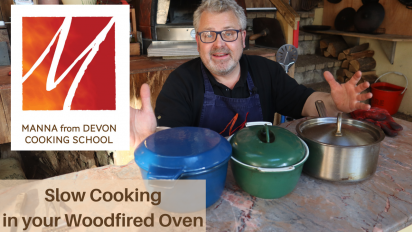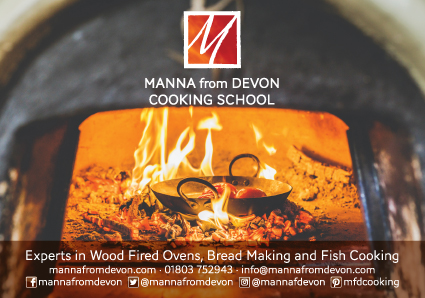Making the most of the retained heat in your woodfired oven
Many people on our woodfired courses have said how much they want to make better use of the retained heat in their woodfired oven after a pizza session or a roast lunch. Often their early attempts have resulted in a pan of either uncooked ingredients or burnt offerings as the slow cooked dishes they have planned have gone in too soon or the oven doesn’t hold as much heat as they thought.
In the current climate of climbing electricity prices, it makes a lot of sense to use all the heat in your oven, cooking dishes for the week ahead or to fill your freezer.

Dishes prepared, ready for slow cooking.
As with most things in woodfired cooking, there are no right or wrong answers and it depends on many variables such as –
- The amount of thermal mass (the stuff that stores the heat) in the oven
- How well insulated is the oven?
- Is it a traditional refractory oven or a modern metal oven?
- How much heat has been put into the oven during the earlier cooking session? Is the oven saturated with heat or just a little warmed through?
- How much food are you planning to cook? One small dish will need a lot less energy that several large ones.
- Is the oven dry? A damp oven will cool much more rapidly that a dry one.
Have a look at our video on slow cooking in the woodfired oven to get you started.
Here are a few things we’ve found from using the heat in our Bushman Santorini.
You Oven is a Battery
The thermal mass of an oven absorbs energy pretty quickly as the fire burns inside. A well built, well insulated oven stores that energy and releases it as heat relatively slowly. If you have been cooking with a fire burning then the oven will be charged with energy in the same way that your phone is charged when it’s plugged in.
When you cook in the oven using just the retained heat you draw that energy back out just as you do when running applications on your phone. Ask it to do one small task and it will have plenty of oomph for a long time, but expect it to run multiple applications at once and it will run out of juice more quickly. The trick is to learn how much energy your oven holds and how many tasks it will complete before it needs a recharge. Then you can plan what to cook and be confident that your oven is up to the job.
Conversely, if you have a fully charged oven banging out lots of heat it may frazzle one or two small dishes. All ovens are not equal so knowing how much energy the oven has in it, and when to stick your beautifully prepared dishes in, requires some trial and error and a bit of practice.
If you’ve had a fire burning in the oven for several hours then your oven may well be saturated with heat. In this case the thermal mass of the oven will be at around 400C. Close the door at this point and the cooking temperature in the oven (the air temperature) will settle at aroung 275C. This temperature is way too hot for most slow dishes, so don’t put a shoulder of pork in and go to bed; you’ll come back to a blackened nugget of pork in the morning. You’ll either have to wait for the oven to cool or have several dishes ready to cook and put them all in the oven at once. By the time a number of dishes have come up to temperature the oven will have cooled and lost a lot of energy. We once put 8 separate pots of slow cooking recipes into the fully heated Bushman Santorini (60cm internal diameter) and they all cooked perfectly without burning; any one of them on their own would definitely have been ruined.
If you have a modern metal oven like our Alfa 4 Pizze, it won’t have as much thermal mass as a refractory oven but with a good bed of embers and a little feeding, we have heat for 2-3 hours so enough to cook 2-3 dishes, depending on the size.
Longer is Not Always Better …
We love the idea of leaving things in the oven to cook as we sleep but not all dishes benefit from very long cooking. Beans turn to mush. Some meats can become dry if not very carefull cooked. Some meat (e.g. chicken) disintegrates when braised for too long. On the other hand beef shin, oxtails, etc can be safely left for hours and hours. Understand each dish and think through what will happen through several hours of slow cooking.
Plan what you are going to cook
This is not just chopping a few things up and thinking this is going to be awesome with some mash later. Here’s a check list of things to think about before you start –
- Is there space in your freezer for the amount of food you are going to cook – it’s surprising how much you can make if you think about it.
- Have you enough foil or plastic tubs with matching lids that will fit in the freezer.
- Don’t forget a pen to write on the lid what’s in the tub – too many ufos in most people’s freezers (unidentified frozen objects)
- Make sure you have enough pans with lids to cook all the dishes you want to
- Make sure those pans will fit in your oven, especially if you are planning to cook several dishes at once.
- Any softening of onions, carrots etc can be done on the hob or in the woodfired oven in advance
- If you are cooking several dishes and you aren’t used to it, make sure you have a sheet for each recipe and that you’ve prepped and ticked off the ingredients for each recipe before you start cooking otherwise it’s going to get confusing. Ideally I like to have them prepped and mixed as much as possible, in their pans in the fridge (if needed) until you are ready to cook and then you just have to put the pans in the oven and shut the door.
So what are you going to cook –
There are endless recipes for slow cooking but a couple of hours spent putting together some of the following will warm your cockles, literally and metaphorically especially once you realise how little fuel you’ve used (about £5 of kiln dried wood will saturate our Sanorinini with heat, since you asked). The meat in slow cooked dishes is the hard working stuff from the animal’s shoulders and front legs and neck – traditionally cheaper cuts but those pesky chefs have got hold of some of them and they aren’t as cheap as they once were. The good thing is these dishes will also reheat easily in your regular kitchen, or your woodfired oven. I’m starting to salivate listing the dishes just remembering how delicious they were!
- Braised Short Ribs
- Lamb Curry
- Osso Buco
- Chilli con Carne (leave out the chilli spices and beans and you have Bolognese sauce)
- Oxtail Stew
- Lentil Dahl We did cook this in the video with a flame burning in the Morso oven but you can also cook it in a sealed pan in a slow oven. It’s very forgiving – if you don’t have red lentils, split peas or green lentils also work brilliantly
- Garlicky Beans – no recipe yet but soak a pack of dried canellini beans in water overnight, drain and mix with a tin of chopped tomatoes, a chopped onion, plenty of garlic, some thyme and rosemary, some chopped carrots and celery if you have it. Cover with water and put a lid on. Don’t add salt until they are cooked as they won’t soften so well. Check the liquids during cooking and add more water if they are drying out.
- Aubergine Parmigiana
- Vegetable Tagine
- Chicken stock – if you have a roast chicken carcass, put it in a pan with plenty of water, a chopped onion, chopped carrot, a celery stick, some black peppercorns and some fresh herbs – parsley stalks, thyme are our go-tos. Beef bones instead of chicken ones will obviously make beef stock. Just cool, strain and keep in the fridge until you want to use it.
- Rice pudding
- Stewed apple (really doesn’t take very long)
And with the very last of the heat
- dry out some fresh breadcrumbs
- dry out some cherry tomatoes when you next have a glut
- make fruit leathers – not tried this yet but it definitely should work
- meringues
- porridge
We hope that gives you some pointers and ideas – do let us know how you get on and any other suggestions you have for using the retained heat in your oven.
Happy cooking
David and Holly
PS if you want to learn more about woodfired cooking you can do so with us here at the cooking school, at our bases in Suffolk and Edinburgh and via our online courses. More via the website on the link below
Manna from Devon Woodfired Cooking School


